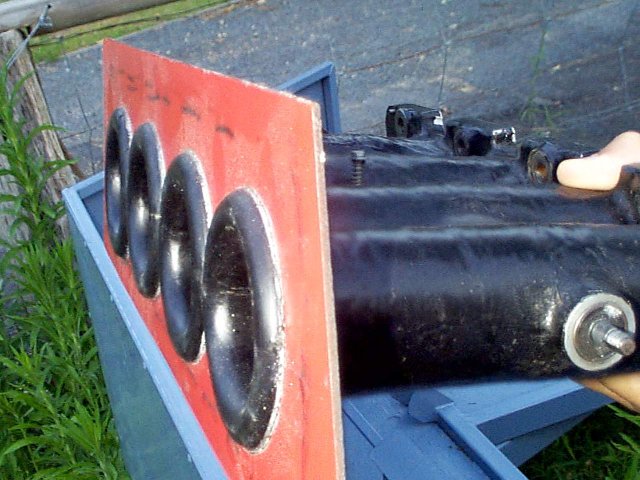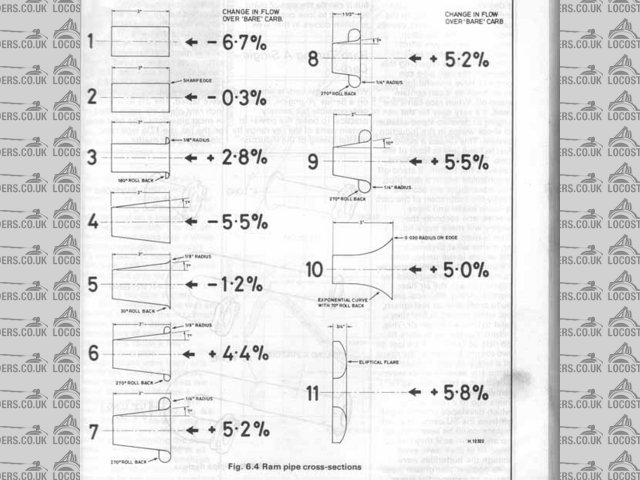
Inlet plenum question
Benzine - 12/5/09 at 07:18 AM
There's probably a simple answer to this but I can't find it from searching or work it out in my head 
I often see inlet manifolds made like this:

Why are the tubes sitting proud of the back plate and not flush with it? Surely they'd create a load of turbulence :/ I also see plenums where
the tubes are flush with the backing plate, why are the two used? Is it different for N/A and forced induction?

dinosaurjuice - 12/5/09 at 07:23 AM
THIS guy aggrees with what you say.
yellow melos - 12/5/09 at 07:48 AM
From the pictures it looks like you are assuming the air is being push in, it's more like being pulled in. ( which isn't a true fact but
it's just too early to go into it  )
)
unless you are running a turbo or super charger of course but then you would not have trumpets like that and it would all be sealed post turbo/super
charger.
MikeRJ - 12/5/09 at 10:24 AM
The whole point of the rolled edges is to reduce turbulence and improve airflow. The larger the arc formed by the rolled egde the better it works
because air is pushed into the trumpet from from all angles, not just straight in. A flat edge would therefore have reduced airflow potential.
[Edited on 12/5/09 by MikeRJ]
Benzine - 12/5/09 at 10:28 AM
quote:
Originally posted by MikeRJ
The whole point of the rolled edges is to reduce turbulence and improve airflow. The larger the arc formed by the rolled egde the better it works
because air is pushed into the trumpet from from all angles, not just straight in. A flat edge would therefore have reduced airflow potential.
Would the rolled edge not be best just proud of the back plate then? Like in the link dinosaurjuice posted:

If you have the rolled edge proud then wouldn't you have the sharp edge at the bottom of the rolled part and space underneath for air to go
mental?
[Edited on 12/5/09 by Benzine]
flak monkey - 12/5/09 at 11:37 AM
The best flow is obtained from a ram pipe similar to the pic above, but with an elliptical profile.
There was some experiments carried out and the results published. There is a picture somewhere with all the different designs on and the comparison
between the flows next to each, but I can't find it for the life of me.
David
nstrug - 12/5/09 at 11:37 AM
quote:
Originally posted by Benzine
quote:
Originally posted by MikeRJ
The whole point of the rolled edges is to reduce turbulence and improve airflow. The larger the arc formed by the rolled egde the better it works
because air is pushed into the trumpet from from all angles, not just straight in. A flat edge would therefore have reduced airflow potential.
Would the rolled edge not be best just proud of the back plate then? Like in the link dinosaurjuice posted:

If you have the rolled edge proud then wouldn't you have the sharp edge at the bottom of the rolled part and space underneath for air to go
mental?
[Edited on 12/5/09 by Benzine]
This is what the airbox on the R1 looks like - rolled edge of the intakes flush with the baseplate. It's what I've done with the filter
backplate too.
Nick
clairetoo - 12/5/09 at 03:51 PM
quote:
Originally posted by flak monkey
The best flow is obtained from a ram pipe similar to the pic above, but with an elliptical profile.
There was some experiments carried out and the results published. There is a picture somewhere with all the different designs on and the comparison
between the flows next to each, but I can't find it for the life of me.
David
This one 


ram pipe shapes
I `borrowed it from some one on here - sorry , but I cant remember who 
MikeRJ - 12/5/09 at 03:52 PM
quote:
Originally posted by Benzine
Would the rolled edge not be best just proud of the back plate then? Like in the link dinosaurjuice posted:
No, since you are effectively preventing air entering the trumpets from behind the radius. The difference will only be small if you have a generously
rolled edge anyway, but there will be a difference.
Also remember that you generally want to make the inlets as long as possible on a road car, if the trumpets aren't projecting into the air filter
you have wasted the opportunity of longer inlet path for no external change in dimensions.
Claire, that's straight out of David Vizards "Tuning British Leyland's 'A' Series Engine" 
[Edited on 12/5/09 by MikeRJ]
thomas4age - 13/5/09 at 07:02 PM
quote:
Originally posted by clairetoo
I `borrowed it from some one on here - sorry , but I cant remember who 
I have it in my archive, but have gotten it from somewhere to,
anyway the most important reason for having the lips flush on the plate is that: it helps preventiving spitback trhought the intakes on large duration
cams.
best trick to overcome that and creating massive backfires is having that plate.
the reason for airflow is not that pressent when you build it correct, either you have it the right way "like Bill has" or you don't
have a plate behind them at all for at least twice the diameter of the venturi's mounth. having one to close is actually enhancing the flow back
out of the pipe when the intake valve colses, and is very negative in effect on turning the flow around again towards the valve. in other words you
will severly screw up the way the helmholtz pulses exit and enter the ventury with all negative effects. they will be there, but just act wrong on
what the intake versus dropping piston wants to do causeing spitback and backfires.
placing one half way is almost allways a garanty for large balls of blueish light comming from under the hood 
now I do know of certain " tuners
tuners " who think this makes a car quicker, but that remains to be seen.
" who think this makes a car quicker, but that remains to be seen.
FI look at any F1 Airbox from the DF cosworths on, they all have this. as do a lot of other well build engines.
if I was to build a new plenum with round exits I would take #11 from the picture and mount it on a flat plate. that's by far the best you can
have.
Grtz Thomas
[Edited on 13/5/09 by thomas4age]
MikeRJ - 13/5/09 at 08:02 PM
quote:
Originally posted by thomas4age
FI look at any F1 Airbox from the DF cosworths on, they all have this. as do a lot of other well build engines.
How about Ferrari?





 )
) 




 tuners
tuners